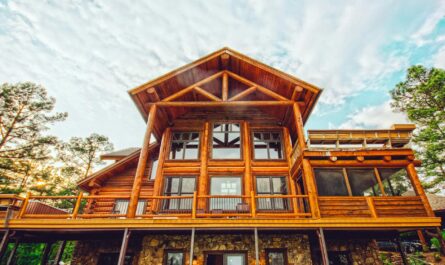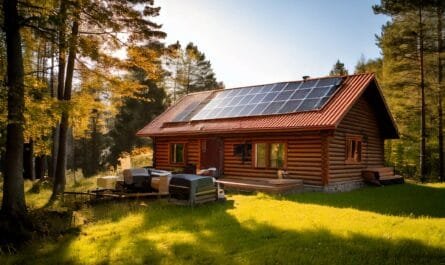The docks are pulled in, the geese are gone, and the first few flakes drift quietly over the bay. November in the Great Lakes region marks that brief pause before winter settles in for good—a time to tighten, seal, and prepare. Whether your cottage sits on Lake Huron’s shoreline or deep in Ontario’s pine country, a little cottage maintenance before snowfall can prevent big headaches later. Here’s a friendly, step-by-step checklist to get your place ready before the first real snowfall.
Images on this page may contain affiliate links in which we may receive a commission. See our affiliate disclosure for details.
Secure the Exterior Before It Freezes

Start with a slow walk around your cottage. Look for anything that creaks, drips, or sags. Loose siding, cracked caulking, or a sagging gutter can turn into a midwinter problem when the temperature dips below freezing. Clean leaves and pine needles out of eavestroughs so melting snow can drain properly once the thaw begins.
Check the roof for missing shingles or gaps in flashing where ice could creep in. A quick fix now can prevent leaks when the snow starts to pile up. If you have storm doors or removable screens, make sure they’re firmly latched or stored indoors. Finish by giving decks and railings a visual once-over—tighten bolts, secure boards, and make note of anything to repair come spring.
Protect Pipes and Plumbing

Frozen pipes are a cottage owner’s nightmare. Before temperatures drop for good, shut off and drain outdoor water lines and garden hoses. Inside, insulate exposed pipes in basements, crawl spaces, or unheated areas.
If your cottage will be closed for the season, turn off the main water supply completely and drain the plumbing. Open faucets to release any trapped water. Pour a small amount of RV antifreeze into sinks, toilets, and floor drains to prevent freezing in traps.
If you plan to visit during the winter, keep your heat on a low setting and keep cabinet doors open under sinks. The goal is simple—no standing water, no burst surprises.
Store Outdoor Furniture and Dock Equipment

The first snow often comes as a surprise, so don’t wait to bring things in. Stack chairs and tables under cover, roll up patio rugs, and secure umbrellas before high winds pick up—clean and dry metal furniture to prevent rust, and cover grills or store them in a shed.
For those lucky enough to have a dock, remove ladders and accessories, and pull in lightweight sections if possible. Dock posts left in the ice can twist or crack as water expands and freezes. It’s better to spend an extra hour now than rebuild in spring. While you’re out there, check that canoes, kayaks, and paddleboards are securely stored—nothing looks sadder than a snow-filled boat in January.
Prepare Heating Systems and Fireplaces

A reliable heat source is the heart of any winter-ready cottage. Start by testing your furnace or baseboard heaters before you need them. Change filters and make sure vents aren’t blocked by rugs or furniture. For propane or oil systems, top off tanks now—delivery trucks can struggle to reach remote roads later in the season.
If your place relies on a wood stove or fireplace, clean it thoroughly and inspect the chimney for soot buildup. A professional sweep every fall prevents both smoke problems and chimney fires. Stack dry firewood at least six feet from the cottage wall and cover it with a tarp that allows air to circulate. When the first storm hits, you’ll be glad you did.
Cottage Maintenance Before Snowfall – Rodent-Proof and Seal Up

When the temperature drops, mice and chipmunks look for the same thing you do: warmth. Inspect the foundation, vents, and gaps around pipes for entry points. Use steel wool or expanding foam to plug small holes. Replace torn window screens and weatherstripping.
Inside, store food in airtight containers or remove it entirely—clean crumbs from cupboards and vacuum under furniture. Peppermint oil sachets or cedar blocks can deter pests, though a few well-placed traps never hurt. A quiet winter cottage should sound like wind on the eaves, not scratching in the walls.
Check Safety Devices and Insurance

Before locking up, test all smoke and carbon monoxide detectors. Replace batteries even if they seem fine—it’s a cheap piece of mind. Ensure fire extinguishers are charged and easily accessible.
Review your insurance policy to confirm it covers seasonal properties through winter. Some policies require heat to be maintained or the water supply to be shut off. A quick call now avoids frustration later if a pipe bursts or a tree branch falls on the roof.
Final Touches Before You Leave

Walk room to room with a notepad. Unplug small appliances, electronics, and lamps. Close curtains to protect fabrics from sun fading but leave them slightly open for light. Set the thermostat low—around 50°F (10°C)—if heat will stay on.
Lock all doors and windows, and leave an emergency key with a trusted neighbor or caretaker. A short checklist taped near the door makes next fall’s opening day easier too.
Before you leave, step outside, take a deep breath, and listen. The lake has its own rhythm this time of year—the hush before the freeze, the quiet crack of branches cooling in the night air. That’s the sound of a cottage ready for winter.
The Comfort of Being Prepared

There’s something deeply satisfying about closing up a cottage the right way. It’s not just maintenance—it’s care. Each task, from draining pipes to stacking wood, is a quiet promise to the place that holds your summer memories. When you return next spring, everything will be as you left it—solid, safe, and waiting.
So check off that final box, pour a cup of cocoa, and watch the first snowflakes fall across the lake. You’ve earned it.



